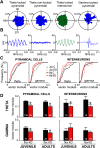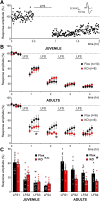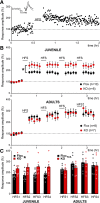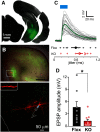Interneuron NMDA Receptor Ablation Induces Hippocampus-Prefrontal Cortex Functional Hypoconnectivity after Adolescence in a Mouse Model of Schizophrenia
- PMID: 32205341
- PMCID: PMC7159887
- DOI: 10.1523/JNEUROSCI.1897-19.2020
Interneuron NMDA Receptor Ablation Induces Hippocampus-Prefrontal Cortex Functional Hypoconnectivity after Adolescence in a Mouse Model of Schizophrenia
Abstract
Although the etiology of schizophrenia is still unknown, it is accepted to be a neurodevelopmental disorder that results from the interaction of genetic vulnerabilities and environmental insults. Although schizophrenia's pathophysiology is still unclear, postmortem studies point toward a dysfunction of cortical interneurons as a central element. It has been suggested that alterations in parvalbumin-positive interneurons in schizophrenia are the consequence of a deficient signaling through NMDARs. Animal studies demonstrated that early postnatal ablation of the NMDAR in corticolimbic interneurons induces neurobiochemical, physiological, behavioral, and epidemiological phenotypes related to schizophrenia. Notably, the behavioral abnormalities emerge only after animals complete their maturation during adolescence and are absent if the NMDAR is deleted during adulthood. This suggests that interneuron dysfunction must interact with development to impact on behavior. Here, we assess in vivo how an early NMDAR ablation in corticolimbic interneurons impacts on mPFC and ventral hippocampus functional connectivity before and after adolescence. In juvenile male mice, NMDAR ablation results in several pathophysiological traits, including increased cortical activity and decreased entrainment to local gamma and distal hippocampal theta rhythms. In addition, adult male KO mice showed reduced ventral hippocampus-mPFC-evoked potentials and an augmented low-frequency stimulation LTD of the pathway, suggesting that there is a functional disconnection between both structures in adult KO mice. Our results demonstrate that early genetic abnormalities in interneurons can interact with postnatal development during adolescence, triggering pathophysiological mechanisms related to schizophrenia that exceed those caused by NMDAR interneuron hypofunction alone.SIGNIFICANCE STATEMENT NMDAR hypofunction in cortical interneurons has been linked to schizophrenia pathophysiology. How a dysfunction of GABAergic cortical interneurons interacts with maturation during adolescence has not been clarified yet. Here, we demonstrate in vivo that early postnatal ablation of the NMDAR in corticolimbic interneurons results in an overactive but desynchronized PFC before adolescence. Final postnatal maturation during this stage outspreads the impact of the genetic manipulation toward a functional disconnection of the ventral hippocampal-prefrontal pathway, probably as a consequence of an exacerbated propensity toward hippocampal-evoked depotentiation plasticity. Our results demonstrate a complex interaction between genetic and developmental factors affecting cortical interneurons and PFC function.
Keywords: NMDA receptor; in vivo electrophysiology; medial PFC; mice; parvalbumin interneuron; schizophrenia.
Copyright © 2020 the authors.
Figures








Similar articles
-
Early NMDA Receptor Ablation in Interneurons Causes an Activity-Dependent E/I Imbalance in vivo in Prefrontal Cortex Pyramidal Neurons of a Mouse Model Useful for the Study of Schizophrenia.Schizophr Bull. 2021 Aug 21;47(5):1300-1309. doi: 10.1093/schbul/sbab030. Schizophr Bull. 2021. PMID: 33822178 Free PMC article.
-
Schizophrenia-Like Dopamine Release Abnormalities in a Mouse Model of NMDA Receptor Hypofunction.Schizophr Bull. 2019 Jan 1;45(1):138-147. doi: 10.1093/schbul/sby003. Schizophr Bull. 2019. PMID: 29394409 Free PMC article.
-
Phencyclidine administration during neurodevelopment alters network activity in prefrontal cortex and hippocampus in adult rats.J Neurophysiol. 2017 Aug 1;118(2):1002-1011. doi: 10.1152/jn.00081.2017. Epub 2017 May 24. J Neurophysiol. 2017. PMID: 28539393 Free PMC article.
-
GABAergic interneuron origin of schizophrenia pathophysiology.Neuropharmacology. 2012 Mar;62(3):1574-83. doi: 10.1016/j.neuropharm.2011.01.022. Epub 2011 Jan 26. Neuropharmacology. 2012. PMID: 21277876 Free PMC article. Review.
-
The origin of NMDA receptor hypofunction in schizophrenia.Pharmacol Ther. 2020 Jan;205:107426. doi: 10.1016/j.pharmthera.2019.107426. Epub 2019 Oct 16. Pharmacol Ther. 2020. PMID: 31629007 Free PMC article. Review.
Cited by
-
Dopamine Receptor Subtypes, Physiology and Pharmacology: New Ligands and Concepts in Schizophrenia.Front Pharmacol. 2020 Jul 14;11:1003. doi: 10.3389/fphar.2020.01003. eCollection 2020. Front Pharmacol. 2020. PMID: 32765257 Free PMC article. Review.
-
Neuromodulation of Hippocampal-Prefrontal Cortical Synaptic Plasticity and Functional Connectivity: Implications for Neuropsychiatric Disorders.Front Cell Neurosci. 2021 Oct 11;15:732360. doi: 10.3389/fncel.2021.732360. eCollection 2021. Front Cell Neurosci. 2021. PMID: 34707481 Free PMC article. Review.
-
Prefrontal Interneurons: Populations, Pathways, and Plasticity Supporting Typical and Disordered Cognition in Rodent Models.J Neurosci. 2022 Nov 9;42(45):8468-8476. doi: 10.1523/JNEUROSCI.1136-22.2022. J Neurosci. 2022. PMID: 36351822 Free PMC article. Review.
-
Structural and Functional Deviations of the Hippocampus in Schizophrenia and Schizophrenia Animal Models.Int J Mol Sci. 2022 May 13;23(10):5482. doi: 10.3390/ijms23105482. Int J Mol Sci. 2022. PMID: 35628292 Free PMC article. Review.
-
Forebrain expression of serine racemase during postnatal development.Neurochem Int. 2021 May;145:104990. doi: 10.1016/j.neuint.2021.104990. Epub 2021 Feb 13. Neurochem Int. 2021. PMID: 33592203 Free PMC article.
References
-
- Bartho P, Hirase H, Monconduit L, Zugaro M, Harris KB (2004) Characterization of neocortical principal cells and interneurons by network interactions and extracellular features. J Neurophysiol 112:11096–11101. - PubMed
Publication types
MeSH terms
Substances
LinkOut - more resources
Full Text Sources
Medical
Molecular Biology Databases
Research Materials
Miscellaneous
